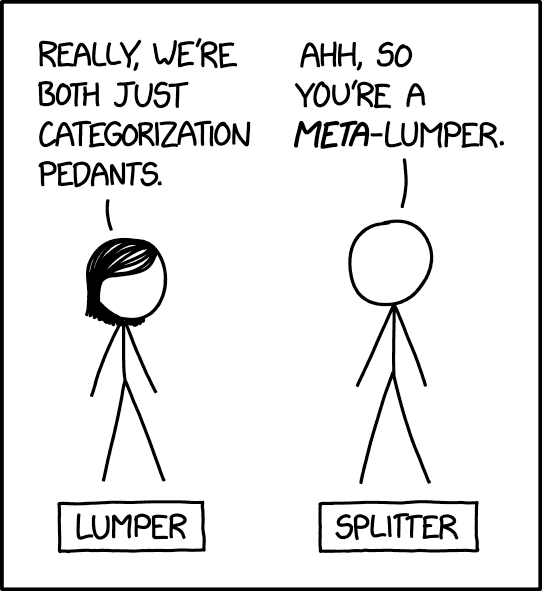Lumpers vs Splitters: How Many Paper Notebooks Do You Use at One Time?
I hesitate to even post this.
Feelings are strong. Emotions run high. I’m a peaceable woman. I hate courting controversy.
But we must address this.
Okay, Anna: Deeeeeeeeeeep breath.
Do you go with One Notebook to Rule Them All? Everything goes in there? Or do you have lots of different notebooks, each dedicated to very specific purposes?
When it comes to paper notebooks, are you a Lumper, or a Splitter?
That’s such a Splitter question!
Can’t we all just be one in this? All one people, who all love our paper notebooks?
That’s such a Lumper reply.
Lumpers and Splitters
Lumping and splitting is about people’s tendencies toward categorization.
The terms originally come from the field of biology, and these tendencies been commented on ever since.
Here’s how an esteemed conchologist opens his article about lumpers and splitters, before he gets into thoughtful nuances which we don’t care about, while we’re stirring up online controversy:
“Authors are often characterized as lumpers or splitters. From one perspective, splitters recognize more species than really exist, and lumpers go around fixing the resulting damage. From another perspective, lumpers are indiscriminating bunglers incapable of appreciating the subtleties of nature.” (Rosenberg 1996)
Lumpers like to gather things into larger, fuzzier categories. They focus on the commonalities.
Splitters like to separate things into smaller, more fine-grained categories. They focus on the differences.
Lumping and splitting tendencies show up anywhere that categorization shows up.
Lumping and splitting absolutely shows up with information management.
How many notebooks do you need?
How many journals?
How many planners?
Are you a lumper, or a splitter?

“One Paper Notebook to Rule Them All”: Some People are Lumpers
“Lumpers” like to throw everything into as few notebooks as possible: preferably, one.
The bullet journal as described in Ryder Carroll’s book, The Bullet Journal Method, is a classic Lumper notebook.
Everything goes into that one notebook: long-term plans, short-term plans, observations, dates, tasks, habit trackers, lists of books you’ve read or movies you’ve seen, lists of books you haven’t read, but want to read, drawings of lemons… in the classic bullet journal system, anything and everything goes into a single notebook.
You keep track of what’s where in a bullet journal, by using a notebook with numbered pages and keeping an index.
When that ONE notebook is filled, you carry over currently relevant information to a new – single – notebook.
One notebook. For all of it.
If this is making you dab the sweat off your forehead, you – like me – might be a Splitter.
“Whoa, Don’t Write THIS in THAT Notebook – THAT Goes in a DIFFERENT Notebook”: Some People Are Splitters
Some people need to keep a work planner separate from their personal planner, for legal reasons. (Many bullet journal discussions online comb over whether or not one should keep a bullet journal for work, and keep a separate one for home.)
But let’s say you are not legally required to keep work notes separate.
Let’s say you can set up your planning system any way you want.
If you use paper planners, and you have a choice, do you have one for work, and a separate one for your personal life?
Splitter.
What about journaling? How many separate dedicated journaling notebooks do you have?
If you’re stopping right now to count: Splitter. (I have six separate journals, in six separate notebooks, with two “pinch hitter” notebooks.)
Here are my notebooks for planning, and ONLY for planning. (Journals not included, drawing books not included, writing notes not included, errands and shopping lists notebooks not included.)

My notebooks:
- capture notebook - the “inbox” notebook
- time and task notebook, organized around quarterly and weekly plans, as well as individual projects
- classic planner notebook for when I need visuals (it has weeks and months laid out)
- day plan notebooks, one for work, one for personal
- checklists
- index cards - when I leave the house I might take an index card with key notes (appts, phone numbers, errand lists)
- pocket notebooks - for notes on the go, which then (if worthy) get entered into the notebooks above
I. Am a SPLITTER!!
There! I said it! Where the WHOLE INTERNET can hear me! Excuse me for a moment while I dab some more sweat off my forehead… splash a little cool water on my face… Ahhhhhhhhhhhh.
It feels so much better to just own who we are, and how we do things, doesn’t it? Liberating.
I am no more able to keep everything in one notebook, than to throw all my forks and knives and spoons higgledy-piggledy into a drawer. For me, the forks go in one slot, the knives in another, and the spoons in still another.
And my daily plans either go into a work notebook, or a personal one. My weekly plans live in a separate notebook, and sometimes I have to think them out with a classic calendar.
Is having one notebook for everything minimalist, or better somehow? I always envied people who could keep their minds straight with just one notebook. But it’s not better if it overwhelms you.
I personally cannot think with one notebook. It all gets jumbled together in my mind. Notebooks to me are like utensil slots: one for this, one for that.
And notebooks are here to help you think. That is what they live for.
If you can think with one notebook at a time, that’s great!
If you think better with multiple notebooks with defined missions, that’s great, too!
The point is to be able to think.
And now, if you’ll excuse me, I have to set up my day plan. In the dedicated Work Day Plan notebook.
Copy and share – the link is here. Never miss a post from the Analog Office! Subscribe here to get blog posts via email.
Wondering how to manage your paper-based or hybrid paper-digital systems? Ask me a question.
REFERENCES
Whence Lumpers and Splitters? | National Center for Science Education (2 December 2014). Available at: https://ncse.ngo/whence-lumpers-and-splitters (Accessed: 19 June 2023).
Rosenberg, G. ‘Lumping and splitting’ (1996) coa. Available at: https://conchologistsofamerica.org/lumping-and-splitting/ (Accessed: 19 June 2023).
Carroll, R. (2018) The Bullet Journal Method: Track the Past, Order the Present, Design the Future. Illustrated edition. New York, New York: Portfolio.
Lumpers and Splitters (no date) xkcd. Available at: https://xkcd.com/2518/ (Accessed: 19 June 2023).